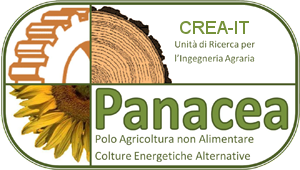Panacea tested a transplantation machine of poplar cutting for short rotation forestry cultivation, in order to set up mechanization systems of biomass cultivations for energy production, so that to reduce the production costs and the surrounding impact of the agronomic techniques used.
It was pointed out the qualities and the performances of the work done, and it was provided for calculating the transplantation costs referred to the typology of the establishment chased (single or twin row).
The tests was made using the prototype developed by Spapperi firm MOD TTP/1, as this operative machine is the only one able to provide, during the work, even for the contemporary drafting of a mulching film, so that to realize the necessary conditions of environment costs restriction, due to the struggle for weeds, usually effected by chemical and mechanical means during the establishment’s first year.
Short rotation forestry plantations must be effectuated in a land, previously manure, ploughed and refined. The poplar establishment is at present executed with cutting of about 300mm of length .The spread materials, once prepared, will be kept in a cold room at around 0°c, and two or three days before the setting up, it will be completely immersed in water , so that to further its rooting. The setting up is executed in vegetative rest period, before the bud opening. The planting system differs from the industry that will withdraw the product: energetic industry or panel one. In the first case, the planting system is of twin row, between which the distance is 2,80 m. The rows are 0,7m far one from each other and with the cutting distance on the row is 0,4m. The investment will be then,14.000 cuttings per hectare. In the case when the product will be delivered to the production’s industry of the panels, the planting system used are of 2,80m x 0,50m , with an investment of 7.100 cuttings/ha.
The developed prototype of the Spapperi firm MOD TTP/1, is a machine carried at the back by the tractor of 1,54m width, 2,10m length , 1,30m height and a mass of 580kg.It is constituted by a leveling system of the land, the plastic film setting and its earthling up, and also by a system of the cutting fitting in land, in the centre of the mulching plastic film . The leveling system of the ground is constituted by a compactor roll of 0,90m diameter width , equal to 0,28m, arranged in an orthogonal position with the reference to the advancing direction, in contact with the land so that to level it. Subsequently, two rhomboidal ploughshares open the necessary lateral furrows for burying the borders of the plastic film. This last one of 0,60m width is constituted by an apposite metal lever put to the ground by an extension roll of 0,62 width, and 0,14m of diameter, after which other two small ploughshares provide to pull down the land upon the borders of the plastic film, and finely two idle pneumatic wheels of 0,24m diameter and 70mm of width, that make its compression.
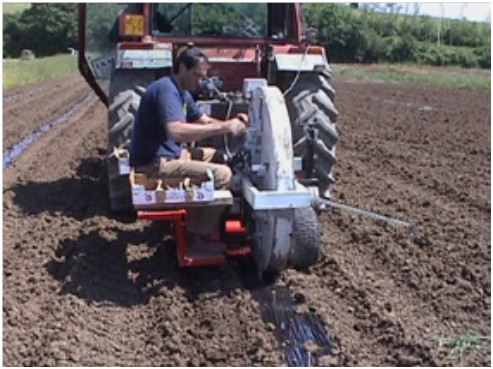 The system that provides the cutting fitting in land is constituted by a metal wheel, 1,3 of diameter and 125mm of width, on which are mounted 8 injector elements, arranged in a radial line and equidistant between themselves.
The system that provides the cutting fitting in land is constituted by a metal wheel, 1,3 of diameter and 125mm of width, on which are mounted 8 injector elements, arranged in a radial line and equidistant between themselves.
Every element, long 0,39m and dimensioned 20mm x 20mm, slides along a guide and is redrafted to the centre by an apposite spring, and to exterior part presents spring pliers on which the operator positions the cutting in the same time that this device is at the favorable position, upward.
The metal wheel idle at its own assets is drug in rotation thanks to the contact with the plastic film, previously arranged on land. And on its rotation, brings the cutting fitted in the injector elements to it. When these ones are on orthogonal position downward referring to the land, a hydraulic jack long 0,37m pushes on the injector element, introducing the cutting on land. This one is released thanks to the opening of the spring pliers. The hydraulic jack’s piston is soldered at a guide on which 2 proximity sensors act and command the piston excursion. (Therefore control the fitting depth of the cutting on earth). A third sensor of proximity, commands the piston working, when this one is positioned in correspondence with the injector element.
The hydraulic piston push permits the cutting fitting even in lands roughly prepared, to avoid the need of cutting it. As a matter of fact this operation has showed the inconvenience of furthering the re-opening of the cut, especially for the clayey lands, during the dry weather, with a consequently rootlet detaching.
Therefore an operator manually fits the cuttings inside the pliers of the injector element, picking them up from a box, and taking care of that the cuttings direction will be exactly to the planted respectively natural position of the buds.
The tested machine was of the kind one, operating in single row and therefore, requested the presence of one tractor driver and one operator, but are available, even transplanting machines, at two columns , on which two transplanting elements are mounted on the same chassis collected to the tractor, requesting then, the presence of a tractor driver and two operators.
In May 2004, in ISMA experimental fields, it was provided to install a SRF poplar plantation, so that to set up mechanical systems for the harvesting of this cultivation, to put the different varieties of poplar in a resting place, so that to compare their productivity.
The middling mixture ground, tending to the clayey and level, was previously prepared with a deep ploughing and two passages of sod breaker.
The Spapperi transplanting machine mod. TTP/1 was connected to a Fiat tractor 80/90. The plantation work was tasked by putting the cutting in a resting place, in 13 rows, 2,8m away from one another, so as to obtain an establishment of 33,4m width and of 130m length.
At the beginning of every row, an employed operated with the burying of the first part, long about 2m, of the mulching film. At the end of every column, the employed provided for the cut of the last part of the plastic film and its burying.
During the work, using the CIOSTA methodology was picked up all the times that characterize the machine productivity in test’s condition.
|
Effective time TE |
% |
75,9 |
|
Turning times TAV |
% |
3,2 |
|
Unloading time TAS |
% |
8,4 |
|
Maintenance time TAC |
% |
3,6 |
|
Accessories time TA |
% |
15,2 |
|
Operative time TO |
% |
91,1 |
|
Preparation in field TPL |
% |
8,9 |
|
Operative efficiency Ro |
n |
83,3 |
|
Effective speed ve |
m/s |
0,332 |
|
Operative speed vo |
m/s |
0,255 |
|
Effective working capacity Ce |
ha/h |
0,334 |
|
Operative working capacity Co |
ha/h |
0,257 |
|
Hourly production Qo |
cut/h |
1794 |
The elaboration of the work’s times, evidenced that the machine, operating at an effective speed of 0,332 m/s, obtains an effective capacity of 0,334 ha/h considering even the additional times, the operative capacity is reduced at 0,257 ha/h, corresponded to an operative time of 3,89 h/ha. In one hour the machine fits 1.794 cuttings in the ground.
The machine requires one tractor driver and one operator.
The relieves that determine the quality of the work done by the machine, regarded the drawing up of the plastic film, leaks, damaged cuttings, cutting’s positioning.
As regarding the first point, during the tests there was no accidental breaking of the plastic film, the rough preparation of the ground and its imperfect leveling, has caused the missed earthling up of one side of the plastic film, in some points.
It was relieved some leaks in a mean measure of 2,1%, while, the cuttings were inserted not in an orthogonal position in land were equal to 3,4% of the inserted cuttings. Then it was even relieved that the cuttings regularly inserted, was broken due the presence of skeleton in the ground.
The leaks and the wrong positions of the cuttings were fundamentally due to the diameter unlikeness of the cuttings used for the tests. In fact the catching part were projected to operate with cuttings diameter varying between 12mm and 28mm. The cuttings of a diameter lower than 12mm, can avoid the catching and fall down before it can insert them. While the cuttings diameter more than 28mm are inclined to stick in the catching part, and after they were inserted in the land, they bend over the advancing direction of the machine, because of the release delay.
Beyond the machine already described, the firm foresees to commercialize even combined machines of more forms for the transplantation, mounted and moved on longeron collected to the connection at three points, so that to effectuate establishments with different ones formats and/or increase the operative capacity of the dockyard.
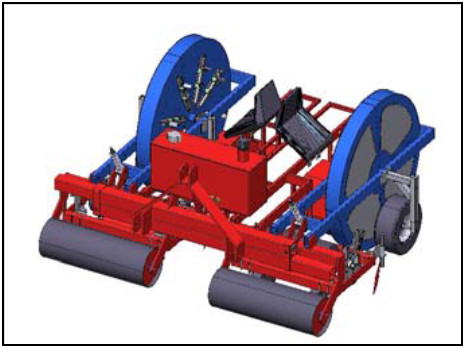 |
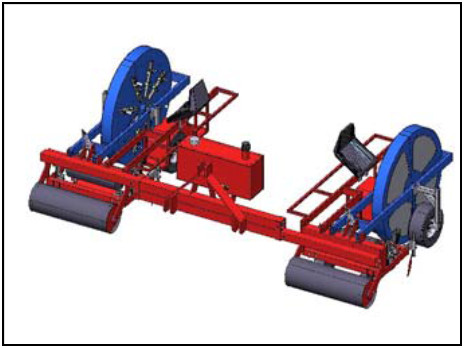 |
By this way it will be commercialized a transplanting machine at two columns. Which will be constituted by two forms for the transplantation mounted on a longeron 2,80m of width, this last one pliable for the transportation as to reduce the hindrance on road. The dockyard will, and then requests one tractor driver and two operators. It is even expected to commercialize a transplantation machine able to transplant two rows. In fact the paired columns establishment is used to increase the number of plants per hectare, permitting also the passing of the machine for the harvesting and the handling of the harvested product.
To furnish some indications to the possibly performance that can have the two row trasplanter described above, and to hourly cost of transplantation, in reference to the machine used, it was calculated the times of work of both machineries in the case that the tractor maintains the same advancing speed and the same additional times relieved on the first machine, constituted by the single row (see table below).
Extrapolation of two rows planting time
|
Unit |
one row planter |
two rows planter |
|
|
Distance between the row |
m |
2,80 |
2,80 |
|
Cut distance in the row |
m |
0,50 |
0,50 |
|
Cutting planted |
cuts/ha |
7140 |
7140 |
|
Number operators |
2 |
3 |
|
|
Machine operative width |
m |
2,30 |
2,80 |
|
Number of row planted |
1 |
2 |
|
|
Effective speed ve |
m/s |
0,332 |
0,332 |
|
Operative speed vo |
m/s |
0,255 |
0,240 |
|
Effective working capacity Ce |
ha/h |
0,334 |
0,668 |
|
Operative working capacity Co |
ha/h |
0,257 |
0,484 |
|
Hourly production Qo |
cuts/h |
1794 |
3386 |
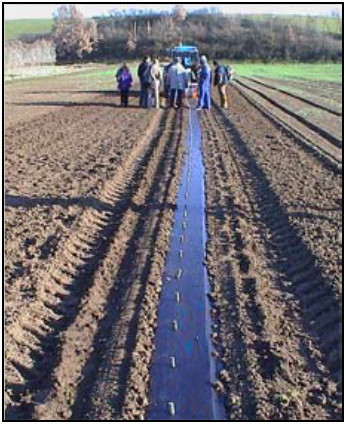
From this extrapolation is deduced that the two column tractor must have a double operative capacity referring to the other, at single one, equal to 0,484ha/h, correspondent to 2,06h/ha, planting a double number of cuttings per hour.
Finely it was calculated the planting cost of the single row, starting by the work times relieved and for the two rows, referring to the cases expressed in the previous paragraph. To calculate the planting costs, it was necessary to proceed with the estimated hypothetical values at new of the two considered machines, not being still on sale. The calculations are referred only to the operative machine, therefore the exercise dockyard cost must provide for the costs regarding the tractor and the tractor driver.
|
Transplanter |
Unit |
one row |
two rows |
|
Acquisition cost (A) |
€ |
15000 |
27000 |
|
Duration (N) |
years |
10 |
10 |
|
Residue value (v) |
€ |
0 |
0 |
|
depreciation (A-v) |
€ |
15000 |
27000 |
|
Yearly utilization (Ul) |
h/year |
1000 |
1000 |
|
Interest rate (r) |
% |
1 |
1 |
|
Salary of operators |
€/h |
10 |
10 |
|
Number of operators |
n° |
2 |
3 |
|
Fixed costs |
|||
|
Amortizing quota (Qa) |
€/year |
1433,73 |
2580,72 |
|
Interests (Qi) |
€/year |
150 |
270 |
|
Minute (Qv) |
€/year |
50 |
50 |
|
Total fixed costs (Qfa) |
€/year |
1633,73 |
2900,72 |
|
Variable costs |
|||
|
Maintenance (qrm) |
€/h |
0,75 |
1,35 |
|
Hydraulic oil (qc) |
€/h |
10,00 |
10,00 |
|
manpower (qo) |
€/h |
20,00 |
30,00 |
|
Total variable costs (qu) |
€/h |
29,75 |
44,35 |
|
Annual cost (Qt) |
€/year |
31383,73 |
47250,72 |
|
Hourly cost (K) |
€/h |
31,38 |
47,25 |
|
Effective working capacity Ce |
ha/h |
0,35 |
0,67 |
|
Planting cost per ha |
€/ha |
85,92 |
66,18 |
|
Plating cost per 1000 cuts |
€/1000 cuts |
12,31 |
9,49 |
It was even considered the presence of one operator at the dockyard service to unwind the additional operations, like the cuttings’ provisioning , the earthing up and the cut of the plastic film, the substitution of the plastic film, verify of the work quality, restoration and some eventually leaks and other additional operations.
It can be noticed, then, how the planting cost for 1000 cuttings planted with the one row is 12,31 € while plated with the two rows is 9,49 €.
The tested machine is able to stretch out the mulching plastic film and planting the poplar cuttings with good qualitative work results. Nevertheless, the single row planter has operative times, even if of a good level within the limits of the harvesting machines, can be sensibly improved regarding the reduction of the short rotation forestry establishment cost. This aspect can be improved increasing the planting apparatus number per machine.
Always, regarding the reducing establishment costs of the short rotation forestry, it is possible to suppose the combining of the transplantation machine with machines used for the tillage and the manuring , so that to execute in just one operation all the stages of transplanting.
The tillage and the manuring executed only where the cutting will be put on rest stay (along the columns), permits, not only a reducing of the costs and the energetic expense of the establishment, but even the reduction of the working environment impacts on the 82% of the surface.
However, it is important to perform a good preparation of the land, sharpen it with care, and this can be coupling a rotary press repointer, to operate at 0,40m of depth, at a rotary press cutter to sharpen a superficial coat of 0,1 – 0,15m.
The prototype is therefore always in evolution, other supposed technological innovations will concern the automation distribution of the cuttings, now manually put on the injector units, innovation that will bring to a real reduction of the establishment costs.
